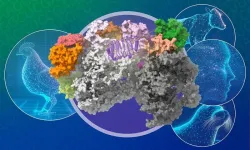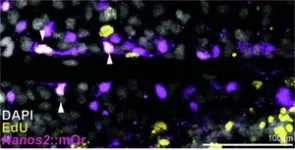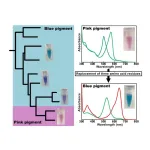(Press-News.org) In recent years, public health measures, surveillance, and vaccination have helped bring about significant progress in reducing the impact of seasonal flu epidemics, caused by human influenza viruses A and B. However, a possible outbreak of avian influenza A (commonly known as ‘bird flu’) in mammals, including humans, poses a significant threat to public health.
The Cusack group at EMBL Grenoble studies the replication process of influenza viruses. A new study from this group sheds light on the different mutations that the avian influenza virus can undergo to be able to replicate in mammalian cells.
Some avian influenza strains can cause severe disease and mortality. Fortunately, significant biological differences between birds and mammals normally prevent avian influenza from spreading from birds to other species. To infect mammals, the avian influenza virus must mutate to overcome two main barriers: the ability to enter the cell and to replicate within that cell. To cause an epidemic or pandemic, it must also acquire the ability to be transmitted between humans.
However, sporadic contamination of wild and domestic mammals by bird flu is becoming increasingly common. Of particular concern is the recent unexpected infection of dairy cows in the USA by an avian H5N1 strain, which risks becoming endemic in cattle. This might facilitate adaptation to humans, and indeed, a few cases of transmission to humans have been reported, so far resulting in only mild symptoms.
At the heart of this process is the polymerase, an enzyme that orchestrates the virus’s replication inside host cells. This flexible protein can rearrange itself according to the different functions it performs during infection. These include transcription – copying the viral RNA into messenger RNA to make viral proteins – and replication – making copies of the viral RNA to package into new viruses.
Viral replication is a complex process to study because it involves two viral polymerases and a host cell protein – ANP32. Together, these three proteins form the replication complex, a molecular machine that carries out replication. ANP32 is known as a ‘chaperone’, meaning that it acts as a stabiliser for certain cellular proteins. It can do this thanks to a key structure – its long acidic tail. In 2015, it was discovered that ANP32 is critical for influenza virus replication, but its function was not fully understood.
The results of the new study, published in the journal Nature Communications, show that ANP32 acts as a bridge between the two viral polymerases – called replicase and encapsidase. The names reflect the two distinct conformations taken up by the polymerases to perform two different functions – creating copies of the viral RNA (replicase) and packaging the copy inside a protective coating with ANP32’s help (encapsidase).
Through its tail, ANP32 acts as a stabiliser for the replication complex, allowing it to form within the host cell. Interestingly, the ANP32 tail differs between birds and mammals, although the core of the protein remains very similar. This biological difference explains why the avian influenza virus does not replicate easily in mammals and humans.
“The key difference between avian and human ANP32 is a 33-amino-acid insertion in the avian tail, and the polymerase has to adapt to this difference,” explained Benoît Arragain, a postdoctoral fellow in the Cusack group and first author of the publication. “For the avian-adapted polymerase to replicate in human cells, it must acquire certain mutations to be able to use human ANP32.”
To better understand this process, Arragain and his collaborators obtained the structure of the replicase and encapsidase conformations of a human-adapted avian influenza polymerase (from strain H7N9) while they were interacting with human ANP32. This structure gives detailed information about which amino acids are important in forming the replication complex and which mutations could allow the avian influenza polymerase to adapt to mammalian cells.
To obtain these results, Arragain carried out in vitro experiments at EMBL Grenoble, using the Eukaryotic Expression Facility, the ISBG biophysical platform, and the cryo-electron microscopy platform available through the Partnership for Structural Biology. “We also collaborated with the Naffakh group at the Institut Pasteur, who carried out cellular experiments,” added Arragain. “In addition, we obtained the structure of the human type B influenza replication complex, which is similar to that of influenza A. The cellular experiments confirmed our structural data.”
These new insights into the influenza replication complex can be used to study polymerase mutations in other similar strains of the avian influenza virus. It is therefore possible to use the structure obtained from the H7N9 strain and adapt it to other strains such as H5N1.
“The threat of a new pandemic caused by highly pathogenic, human-adapted avian influenza strains with a high mortality rate needs to be taken seriously,” said Stephen Cusack, EMBL Grenoble Senior Scientist who led the study and has been studying influenza viruses for 30 years. “One of the key responses to this threat includes monitoring mutations in the virus in the field. Knowing this structure allows us to interpret these mutations and assess if a strain is on the path of adaptation to infect and transmit between mammals.”
These results are also useful in the long-term perspective of anti-influenza drug development, as there are no existing drugs that target the replication complex specifically. “But it's just the beginning," said Cusack. "What we want to do next is to understand how the replication complex works dynamically, in other words, to know in more detail how it actively performs replication." The group has already successfully carried out similar studies on the role of influenza polymerase in the viral transcription process.
END
New insights on how bird flu crosses the species barrier
A new publication from the Cusack group sheds light on how a key avian influenza virus enzyme can mutate to allow the virus to replicate in mammals
2024-08-19
ELSE PRESS RELEASES FROM THIS DATE:
Energy companies pressure landowners into fracking, study shows
2024-08-19
BINGHAMTON, N.Y. -- Energy companies use persistent and personalized pressure to get landowners to give permission for hydraulic fracturing (fracking), and even when landowners decline, companies use legalized compulsion to conduct fracking anyway, according to a new study led by researchers at Binghamton University, State University of New York and UNLV.
“Hydraulic fracturing is a controversial issue, but a lot of the controversy has been focused on the big-picture consequences, for the climate and the economy,” said Benjamin Farrer, lead author and former PhD student at Binghamton University. “One of our hopes for this paper is that it will encourage policymakers ...
UC Irvine team says urban street networks, building density shape severity of floods
2024-08-19
Irvine, Calif., Aug. 19, 2024 — Cities around the globe are experiencing increased flooding due to the compounding effects of stronger storms in a warming climate and urban growth. New research from the University of California, Irvine suggests that urban form, specifically the building density and street network of a neighborhood, is also affecting the intensity of flooding.
For a paper published today in Nature Communications, researchers in UC Irvine’s Department of Civil and Environmental Engineering turned to statistical mechanics ...
Nurses play key role in addressing mental well-being for people after a stroke
2024-08-19
Statement Highlights:
The latest research indicates that 16% to 85% of people recovering from a stroke experience at least one psychosocial symptom, including depression, anxiety, stress, fatigue and/or decreased quality of life.
Critical nursing interventions, such as regular mental health screenings, education, symptom management and follow-up care, are key to reducing the negative effects on a patient’s mental well-being after a stroke, yet only a small proportion of patients receive treatment. ...
Why these educators believe whole-class reading creates a sense of community in the classroom
2024-08-19
With teaching methods for reading and writing under constant scrutiny, and high-stakes testing creating intense pressure to teach strictly to state standards, is there still value in whole-class reading?
Two educators believe that whole-class reading should go hand-in-hand with individual instructional reading, and they say it is vital for cultivating a sense of classroom community while developing critical thinking in young minds.
Educators Lynsey Burkins and Franki Sibberson, both teachers and educators from Ohio, have published a book called In Community ...
Researchers develop an instant version of trendy, golden turmeric milk
2024-08-18
DENVER, Aug. 18, 2024 — If you’ve visited a trendy café in the past few years, you might have noticed “golden” turmeric milk on the menu. Though recently advertised as a caffeine-free, healthy coffee alternative, the drink is a fancified version of haldi doodh — a traditional Indian beverage often used as an at-home cold remedy. And now, researchers have developed an efficient method to make a plant-based, instant version that maintains the beneficial properties of the ingredients while also extending its shelf life.
The researchers will present their results at the fall meeting of the American Chemical Society (ACS). ...
Peering into the mind of artificial intelligence to make better antibiotics
2024-08-18
DENVER, Aug. 18, 2024 — Artificial intelligence (AI) has exploded in popularity. It powers models that help us drive vehicles, proofread emails and even design new molecules for medications. But just like a human, it’s hard to read AI’s mind. Explainable AI (XAI), a subset of the technology, could help us do just that by justifying a model’s decisions. And now, researchers are using XAI to not only scrutinize predictive AI models more closely, but also to peer deeper into the field of chemistry.
The researchers will present ...
Evidence stacks up for poisonous books containing toxic dyes
2024-08-18
DENVER, Aug. 18, 2024 — If you come across brightly colored, cloth-bound books from the Victorian era, you might want to handle them gently, or even steer clear altogether. Some of their attractive hues come from dyes that could pose a health risk to readers, collectors or librarians. The latest research on these poisonous books used three techniques — including one that hasn’t previously been applied to books — to assess dangerous dyes in a university collection and found some volumes may be unsafe to handle.
The researchers will present their results at the fall meeting of the American Chemical Society (ACS). ACS Fall 2024 is a hybrid meeting being ...
Novel photoreceptor sheds light on how cyanobacteria see color
2024-08-17
Tokyo, Japan – Scientists from Tokyo Metropolitan University have identified a new photoreceptor in cyanobacteria with a modification in part of its structure which makes it sensitive to green/teal light. The photoreceptor belongs in a family usually sensitive to red/green light in the environment. They identified the parts of its amino acid structure responsible for this behavior; editing them helped restore sensitivity to red and green light, a remarkable example of molecular “plasticity” in action.
Cyanobacteria, also known as blue-green algae, are phenomenally important players ...
The bee’s knees: New tests created to find fake honey
2024-08-17
Researchers led by Cranfield University have developed new ways to detect sugar syrup adulteration in honey, paving the way for fast and accurate tests to discover fake products.
There is growing consumer demand for honey, with £89.8 million worth of honey imported to the UK in 2023. But as a high-value product it is vulnerable to fraud, with syrups added to dilute the pure honey – a report from the European Commission in 2023 found 46% of 147 honey samples tested were likely to have been adulterated with cheap plant syrups.
Because honey’s characteristics vary due to sources of nectar, season of harvest and ...
Sustainably reducing inappropriate IV use by more than a third
2024-08-17
Sustainably reducing inappropriate IV use by more than a third
Reasearch led by Amsterdam UMC, across more than 5 years and 1100 patients has demonstrated a strategy for reducing inappropriate IV use by a third, an effect that was sustained across the five-year period. This should also lead to reduction in the associated infections that effect one in ten patients. These results are published today in The Lancet eClinicalMedicine.
"Infections caused by both IVs and catheters occur in more than 10% of patients and studies indicate that up to a quarter are not necessary. Simply, this means that patients are placed at ...
LAST 30 PRESS RELEASES:
Scientists use ultrasound to soften and treat cancer tumors without damaging healthy tissue
Community swimming program for Black youth boosts skills, sense of belonging, study finds
Specific depressive symptoms in midlife linked to increased dementia risk
An ‘illuminating’ design sheds light on cholesterol
Who is more likely to get long COVID?
Study showcases resilience and rapid growth of “living rocks”
Naval Research Lab diver earns Office of Naval Research 2025 Sailor of the Year
New Mayo-led study establishes practical definition for rapidly progressive dementia
Fossil fuel industry’s “climate false solutions” reinforce its power and aggravate environmental injustice
Researchers reveal bias in a widely used measure of algorithm performance
Alcohol causes cancer. A study from IOCB Prague confirms damage to DNA and shows how cells defend against it
Hidden viruses in wastewater treatment may shape public health risks, study finds
Unlock the power of nature: how biomass can transform climate mitigation
Biochar reshapes hidden soil microbes that capture carbon dioxide in farmland
Reducing saturated fat intake shows mortality benefit, but only in high-risk individuals
Manta rays create mobile ecosystems, study finds
Study: Mixed results in using lipoic acid to treat progressive multiple sclerosis
Norbert Holtkamp appointed director of Fermi National Accelerator Laboratory
New agentic AI platform accelerates advanced optics design
Biologists discover neurons use physical signals — not electricity — to stabilize communication
Researchers discover that a hormone can access the brain by hitchhiking
University of Oklahoma researcher awarded funding to pursue AI-powered material design
Exploring how the visual system recovers following injury
Support for parents with infants at pediatric check-ups leads to better reading and math skills in elementary school
Kids’ behavioral health is a growing share of family health costs
Day & night: Cancer disrupts the brain’s natural rhythm
COVID-19 vaccination significantly reduces risk to pregnant women and baby
The role of vaccination in maternal and perinatal outcomes associated with COVID-19 in pregnancy
Mayo Clinic smartwatch system helps parents shorten and defuse children's severe tantrums early
Behavioral health spending spikes to 40% of all children’s health expenditures, nearly doubling in a decade
[Press-News.org] New insights on how bird flu crosses the species barrierA new publication from the Cusack group sheds light on how a key avian influenza virus enzyme can mutate to allow the virus to replicate in mammals







